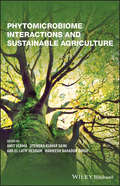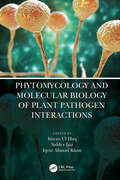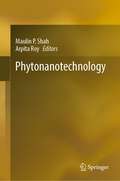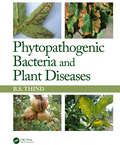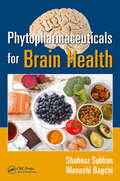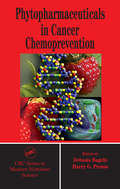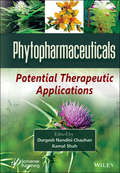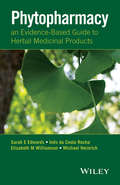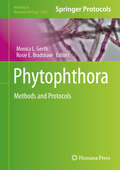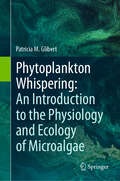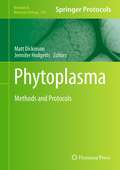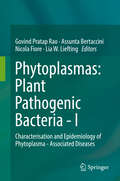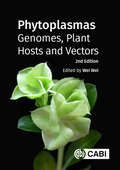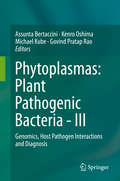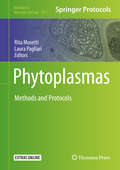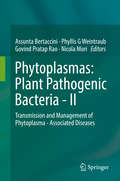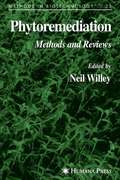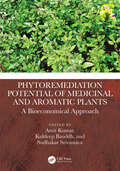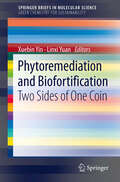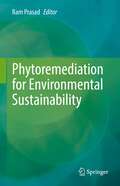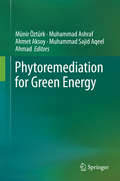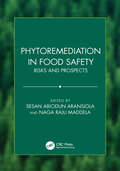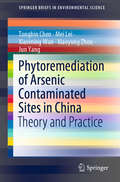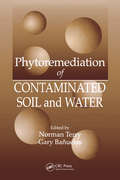- Table View
- List View
Phytomicrobiome Interactions and Sustainable Agriculture
by Harikesh Bahadur Singh Abd El-Latif Hesham Amit Verma Jitendra Kumar SainiA guide to the role microbes play in the enhanced production and productivity of agriculture to feed our growing population Phytomicrobiome Interactions and Sustainable Agriculture offers an essential guide to the importance of ‘Phytomicrobiome’ and explores its various components. The authors – noted experts on the topic – explore the key benefits of plant development such as nutrient availability, amelioration of stress and defense to plant disease. Throughout the book, the authors introduce and classify the corresponding Phytomicrobiome components and then present a detailed discussion related to its effect on plant development: controlling factors of this biome, its behaviour under the prevailing climate change condition and beneficial effects. The book covers the newly emerging technical concept of Phytomicrobiome engineering, which is an advanced concept to sustain agricultural productivity in recent climatic scenario. The text is filled with comprehensive, cutting edge data, making it possible to access this ever-growing wealth of information. This important book: Offers a one-stop resource on phytomicrobiome concepts Provides a better understanding of the topic and how it can be employed for understanding plant development Contains a guide to sustaining agriculture using phytomicrobiome engineering Presents information that can lead to enhanced production and productivity to feed our growing population Written for students, researchers and policy makers of plant biology, Phytomicrobiome Interactions and Sustainable Agriculture offers a clear understanding of the importance of microbes in overall plant growth and development.
Phytomycology and Molecular Biology of Plant Pathogen Interactions
by Dr Imran Ul Haq Dr Siddra Ijaz Dr Iqrar Ahmad KhanPlants are exposed to highly diverse microbiota forming complex interactions in natural environments. Phytomycology and Molecular Biology of Plant Pathogen Interactions presents information on defense mechanisms of the plants, as various microbes can have positive effects on their plant hosts. Key Features Delineates the journey from Koch’s postulate to molecular systems biology. Provides comprehensive information on fungal biology, pathogenicity genes, and their expression while interacting with host plants. Highlights the techniques and approaches involved in phytofungi identification and detection. Describes multi-omics approaches and metabolic engineering in plant fungi. This book is beneficial to readers including plant scientists and researchers, particularly plant pathologists, molecular biologists, and mycologists.
Phytonanotechnology
by Maulin P. Shah Arpita RoyThis book provides essential information on the role of phytonanotechnology in the removal of environmental pollutants and covers recent advances in experimental and theoretical studies on plant-derived nanoparticles. It also discusses their current and potential applications and challenges.The combination of nanotechnology and phytoremediation, which is called phytonanotechnology, have the potential to remove contaminants from the environment or degrade them. The efficiency of contaminant removal can be improved by combining both methods as they are complementary to each other.Phytonanotechnology offers the advantages of increased bioavailability, prolongation of heavy metal absorption time, and multiple metal removal, all contributing to improved efficacy and decreased toxicity in plants and surroundings. Therefore, there is immense scope for nature-derived molecules to be formulated into nanotechnology-based phytoremediation approaches targeting the specific heavy metal removal from effluents and surroundings. This encourages research initiatives to synthesize more phytonanotechnology based uptake plant systems with high efficiency. Efficient formulation targeting strategies and the evaluation of targeting efficiency of phytonanotechnology, conforming to international standards of their toxicology and biocompatibility, could pave the way for heavy metal uptake and removal by plant-based systems.This book serves as a valuable resource for postgraduate students, environmental scientists and materials scientists in academia and corporate research.
Phytopathogenic Bacteria and Plant Diseases
by BS ThindThe field of Phytobacteriology is rapidly advancing and changing, because of recent advances in genomics and molecular plant pathology, but also due to the global spread of bacterial plant diseases and the emergence of new bacterial diseases. So, there is a need to integrate understanding of bacterial taxonomy, genomics, and basic plant pathology that reflects state-of-the-art knowledge about plant-disease mechanisms. This book describes seventy specific bacterial plant diseases and presents up-to-date classification of plant pathogenic bacteria. It would be of great help for scientists and researchers in conducting research on ongoing projects or formulation of new research projects. The book will also serve as a text book for advanced undergraduate and postgraduate students of disciplines of Phytobacteriology and Plant Pathology. Contains latest and updated information of plant pathogenic bacteria till December 2018 Describes seventy specific bacterial diseases Presents classification of the bacteria and associated nomenclature based on Bergey’s Manual Systematic Bacteriology and International Journal of Systematic and Evolutionary Microbiology Discusses practical and thoroughly tested disease management strategies that would help in controlling enormous losses caused by these plant diseases Reviews role of Type I-VI secretion systems and peptide- or protein-containing toxins produced by bacterial plant pathogens Briefs about plants and plant products that act as carriers of human enteric bacterial pathogens, like emphasizing role of seed sprouts as a common vehicle in causing food-borne illness Dr B. S. Thind was ex-Professor-cum-Head, Department of Plant Pathology, Punjab Agricultural University Ludhiana, India. He has 34 years of experience in teaching, research, and transfer of technology. He has conducted research investigations on bacterial blight of rice, bacterial stalk rot of maize, bacterial blight of cowpea, bacterial leaf spot of green gram, bacterial leaf spot of chillies and bacterial soft rot of potatoes. He also acted as Principal Investigator of two ICAR-funded research schemes entitled, "Detection and control of phytopathogenic bacteria from cowpea and mungbean seeds from 1981 to 1986 and "Perpetuation, variability, and control of Xanthomonas oryzae pv. oryzae, the causal agent of bacterial blight of rice" from 1989 to 1993, and also of a DST funded research scheme "Biological control of bacterial blight, sheath blight, sheath rot, and brown leaf spot of rice" from 1999 to 2002. He also authored a manual entitled, "Plant Bacteriology" and a text book entitled, "Phytopathogenic Procaryotes and Plant Diseases" published by Scientific Publishers (India). He is Life member of Indian Phytopathological Society, Indian Society of Plant Pathologists, Indian Society of Mycology and Plant Pathology, and Indian Science Congress Association.
Phytopharmaceuticals for Brain Health
by Manashi Bagchi Shahnaz SubhanResearch studies demonstrate diet and proper nutrition in conjunction with cognitive, mental, social, and physical activities can significantly help in improving brain health with advancing age, and potentially reduce the risk of cognitive decline. These studies of phytopharmaceuticals and medicinal plants, demonstrate the efficacy of Huperzine A, berry anthocyanins, trans-resveratrol, Ginkgo biloba, Bacopa monniera, Centella asiatica, tocotrienols, and palm oil in boosting brain health and physical well-being. In addition, consumption of marine fishes and general seafood is recommended for long-term nutritional intervention to preserve mental health, hinder neurodegenerative processes, and sustain cognitive capacities in humans. Omega-3 and omega-6 polyunsaturated fatty acids, n-3/n-6 PUFAs, flavonoids, and antioxidants prevent the initiation and progression of many neurological disorders. This book is a comprehensive review of phytopharmaceuticals impacting brain health with emphasis on diverse applications in food and nutrition sciences, biomedicine, neurology and other scientific and medical fields. It details available methods and contains numerous references making this the perfect guide for scientists who want to explore the fascinating world of phytopharmaceuticals with relation to brain health. Phytopharmaceuticals for Brain Health appeals to a diverse range of readers in industry, medical doctors, research and academia, including biologists, biochemists, food scientists, nutritionists and health professionals. Overall, this book brings a classic scenario of neurological problems to possible amelioration using novel nutraceuticals and functional foods.
Phytopharmaceuticals in Cancer Chemoprevention
by Harry G. Preuss Debasis BagchiDuring the past decade, a significant amount of research has been conducted on phytopharmaceuticals. Today, a growing body of evidence demonstrates the efficacy of a wide variety of natural products and affirms their potential in the treatment of cancer. Phytopharmaceuticals in Cancer Chemoprevention focuses on the role of natural supplemen
Phytopharmaceuticals: Potential Therapeutic Applications
by Durgesh Nandini Chauhan Kamal ShahMedicinal plants contain a variety of bioactive compounds, (also referred to as phytochemicals). in the leaves, stems, flowers and fruits. This book covers these bioactive compounds, their available sources, how the bioactive molecules are isolated from the plants, the biochemistry, structural composition and potential biological activities. Also discussed are the pharmacological aspects of medicinal plants, phytochemistry and biological activities of different natural products, ethnobotany and medicinal properties, as well as a novel dietary approach for various disease management and therapeutic potential. The importance of phytopharmaceutical of plants and potential applications in the food and pharma industries is highlighted.
Phytopharmacy: An Evidence-Based Guide to Herbal Medicinal Products
by Michael Heinrich Elizabeth M. Williamson Sarah E. Edwards Ines da Costa RochaHealthcare professionals, including doctors, pharmacists and nurses, are often confronted with patients who use over-the-counter (OTC) herbal medicinal products and food supplements. While taking responsibility for one’s own health and treatment options is encouraged, many patients use these products based on limited (and sometimes inaccurate) information from non-scientific sources, such as the popular press and internet. There is a clear need to offer balanced, well-informed advice to patients, yet a number of studies have shown that, generally, conventionally trained health practitioners consider their knowledge about herbal medicinal products and supplements to be weak. Phytopharmacy fills this knowledge gap, and is intended for use by the busy pharmacist, nurse, or doctor, as well as the ‘expert patient’ and students of pharmacy and herbal medicine. It presents clear, practical and concise monographs on over a hundred popular herbal medicines and plant-based food supplements. Information provided in each monograph includes: • Indications• Summary and appraisal of clinical and pre-clinical evidence• Potential interactions• Contraindications• Possible adverse effectsAn overview of the current regulatory framework is also outlined, notably the EU Traditional Herbal Medicinal Products Directive. This stipulates that only licensed products or registered traditional herbal medicinal products (THRs), which have assured quality and safety, can now legally be sold OTC. Monographs are included of most of the major herbal ingredients found in THRs, and also some plant-basedfood supplements, which while not strictly medicines, may also have the potential to exert a physiological effect.
Phytophthora: Methods and Protocols (Methods in Molecular Biology #2892)
by Monica L. Gerth Rosie E. BradshawThis comprehensive volume examines techniques for studying Phytophthora species, a devastating group of plant pathogens that cause diseases in crops and natural ecosystems worldwide. The book compiles essential molecular techniques and methods, such as CRISPR-Cas genome editing for investigating pathogenicity and resistance, as well as tools for detecting, visualizing, and quantifying disease. Written for the highly successful Methods in Molecular Biology series, each chapter includes an introduction to its respective topic, lists of the necessary materials and reagents, step-by-step and readily reproducible laboratory protocols, and tips on troubleshooting and avoiding known pitfalls. Authoritative and practical, Phytophthora: Methods and Protocols equips researchers with the tools needed to address the challenges posed by these destructive microorganisms.
Phytoplankton Pigments
by Suzanne Roy Einar Skarstad Egeland Geir Johnsen Carole A. LlewellynPigments act as tracers to elucidate the fate of phytoplankton in the world's oceans and are often associated with important biogeochemical cycles related to carbon dynamics in the oceans. They are increasingly used in in situ and remote-sensing applications, detecting algal biomass and major taxa through changes in water colour. This book is a follow-up to the 1997 volume Phytoplankton Pigments in Oceanography (UNESCO Press). Since then, there have been many advances concerning phytoplankton pigments. This book includes recent discoveries on several new algal classes particularly for the picoplankton, and on new pigments. It also includes many advances in methodologies, including liquid chromatography-mass spectrometry (LC-MS) and developments and updates on the mathematical methods used to exploit pigment information and extract the composition of phytoplankton communities. The book is invaluable primarily as a reference for students, researchers and professionals in aquatic science, biogeochemistry and remote sensing.
Phytoplankton Whispering: An Introduction to the Physiology and Ecology of Microalgae
by Patricia M. GlibertPhytoplankton, or algae, are the engines of the Earth. They form the base of the aquatic food web and, although microscopic, they produce 50% of the oxygen in the air. Many of our ideas of what makes these cells “tick” come from ideas developed decades ago. But, lakes and oceans are changing- and so, too are phytoplankton. Our understanding has to change accordingly. Nutrient pollution is a major problem worldwide, and climate is changing, altering temperature, CO2 and pH, as well as the physics that control water stratification. All of these factors control which species of phytoplankton may grow well at any particular time. While algae grow in all types of aquatic systems, not all algae are favorable for the production of fish and other food resources. The prevalence of harmful algal blooms (HABs) has increased. At the core of this effort is a drive to understand–and to convey to researchers, students and managers–what kinds of phytoplankton are likely to thrive as conditions change and why this matters. There has not yet been a synthetic summary that unravels the mysteries of phytoplankton in a modern world. This book aims to provide such a resource.
Phytoplasma
by Matt Dickinson Jennifer HodgettsPhytoplasmas are a group of bacteria that are capable of multiplying and causing severe diseases in a wide range of plant species and are transported between plants by insect vectors in which the bacteria can also multiply. Phytoplasmas can cause serious and devastating problems for crop plants, especially in developing countries. In Phytoplasmas: Methods and Protocols experts in the field cover topics pertinent to scientists intending to develop a research program on phytoplasmas. The volume opens with an introductory chapter on the importance of phytoplasma diseases, followed by methods for detection and diagnosis as well as techniques for separating and classifying the phytoplasmas into their different taxonomic groups and subgroups. The final chapters cover methods for separating phytoplasma genomic and plasmid DNA from plant DNA for whole genome sequencing. Written in the successful Methods in Molecular BiologyTM series format, chapters include introductions to their respective topics, lists of the necessary materials and reagents, step-by-step, readily reproducible protocols, and notes on troubleshooting and avoiding known pitfalls. Authoritative and easily accessible, Phytoplasmas: Methods and Protocols serves as an ideal guide to plant pathologists and molecular biologists aiming to set up a diagnostics facility for identifying the presence of these pathogens in plants or their insect vectors.
Phytoplasmas: Characterisation And Epidemiology Of Phytoplasma - Associated Diseases
by Assunta Bertaccini Govind Pratap Rao Nicola Fiore Lia W. LieftingPhytoplasma-associated diseases are a major limiting factor to quality and productivity of many ornamentals, horticultural and other economically important agriculture crops worldwide. Annual losses due to phytoplasma diseases in many crops vary, but under the pathogen favorable conditions they always lead to disastrous consequences to farming community. As there is no effective cure for phytoplasma diseases, the management options emphasize on their exclusion, minimizing their spread by insect vectors and propagation materials and on development of host plant resistance. The phytoplasma associated plant diseases have a history of more than 50 years. Phytoplasmas have undoubtedly infected plants and cause diseases for centuries before they are described and proven to be the causal agents. But important progress related to identification of phytoplasmas only began after 1980’s. Phytoplasmas have emerged as the most serious constraints in the production of several crops all around the world during last four decades. Phytoplasmas constitute a major limiting factor to quality and productivity of cereals, horticultural, ornamentals and many other economically important crops all over the world. Annual losses due to phytoplasma diseases may vary, but under the pathogen favorable condition, phytoplasma disease may lead to disastrous consequences for farming and industry community. The scientific literature concerning phytoplasma occurrence, characterization, diagnosis, detection, and management is growing at a fast pace. Significant advancement in the last decades on diagnostic, biological and molecular properties, epidemiology, host-pathogen-insect interactions as well as management of phytoplasmas has been made. Till date, no authentic compilation is available to know the progress of phytoplasmas characterization major crops all over the world. The planned book will compile all the updated information available information on phytoplasmas by distinguished experts in the form of edited book entitled “Characterization and epidemiology of phytoplasma associated diseases”. The book covers recent and update information on emerging and re-emerging phytoplasma diseases affecting important crops in tropics and subtropics. It provides comprehensive information on disease distribution, occurrence, and identification of the phytoplasmas including the recent approaches for diagnostics, transmission, and information about losses and geographical distribution along with and management aspects. This volume contains 11-12 chapters contributed by the experienced and recognized experts working on different group of phytoplasmas affecting major crops all over the world. The information on various topics is at advanced as well as comprehensive level and provides the period wise developments of phytoplasma research. The book covers major chapters on an up to date progress of phytoplasma research, and then phytoplasma diseases associated with vegetable, pulse, oils crops, cereals, sugar crops, fruit crops, ornamentals, medicinal plants, palms species, forest tress and weeds. We have covered historical background, geographical distribution, identification and characterization, genetic diversity, host pathogen interaction and management aspects of important phytoplasma diseases infecting our major agricultural crops. The information on various topics is advanced as well as comprehensive, and provides thought provoking ideas for planning novel research ideas for future. This book will be useful to everyone interested in mollicutes, phytoplasma, spiroplasmas, plant pathology, disease control and plant biology and serve as an exhaustive and up-to-date compendium of references on various aspects of different groups of phytoplasmas affecting important crops worldwide.
Phytoplasmas: Genomes, Plant Hosts and Vectors
This is a comprehensive and up-to-date resource that delves into the world of phytoplasmas - tiny bacteria that infect plants, causing diseases with significant agricultural and horticultural implications. This new edition combines the latest scientific knowledge, cutting-edge methodologies, and practical insights to provide a complete picture of phytoplasma research, from taxonomy to disease management. It presents in-depth coverage of phytoplasma phylogenetics, epidemiology, vector control strategies, and host-pathogen interactions. It covers the molecular mechanisms underpinning phytoplasma infections and explores recent breakthroughs in genome sequencing techniques. This edition also highlights the importance of precision agriculture principles in phytoplasma disease management and discusses novel approaches such as RNA interference for disrupting phytoplasma transmission.
Phytoplasmas: Genomics, Host Pathogen Interactions and Diagnosis
by Assunta Bertaccini Govind Pratap Rao Kenro Oshima Michael KubePhytoplasma III is the last of three books in the series covering all the aspects of phytoplasma-associated diseases. Phytoplasmas are a major limiting factor in the quality and productivity of many ornamental, horticultural and economically important agriculture crops worldwide, and losses due to phytoplasma diseases have disastrous consequences for farming communities. As there is no effective cure for these diseases, management strategies focus-on exclusion, minimizing their spread by insect vectors and propagation materials, and developing host plant resistance. This book provides an update on genomics, effectors and pathogenicity factors toward a better understanding of phytoplasma-host metabolic interactions. It offers a comprehensive overview of biological, serological and molecular characterization of the phytoplasmas, including recently developed approaches in diagnostics, such as transcriptomics studies, which have paved the way for analyzing the gene expression pattern in phytoplasmas on infection and revealed the up-regulation of genes associated with hormonal response, transcription factors, and signaling genes. Although phytoplasmas remain the most poorly characterized pathogens, recent studies have identified virulence factors that induce typical disease symptoms and have characterized the unique reductive evolution of the genome. Reviewing the advances in cultivation in axenic media together with the perspectives for future research to reduce the global incidence of these pathogens and the associated agricultural losses, the book is a valuable resource for plant pathologists, researchers in agriculture and PhD students.
Phytoplasmas: Methods And Protocols (Methods in Molecular Biology #1875)
by Rita Musetti Laura PagliariThis book presents a set of modern protocols forming a solid background for who want to start or improve research programme on phytoplasmas. Chapters guide readers through detailed techniques for maintaining phytoplasma collections, border inspection, detection of different phytoplasma strains, new pipelines to produce phytoplasma genome draft, protocols for phytoplasma gene expression analyses, and methods for the investigation of the phloem tissue. Written in the highly successful Methods in Molecular Biology series format, chapters include introductions to their respective topics, lists of the necessary materials and reagents, step-by-step, readily reproducible laboratory protocols, and tips on troubleshooting and avoiding known pitfalls. Authoritative and cutting-edge, Phytoplasmas: Methods and Protocols aims to ensure successful results in the further study of this vital field.
Phytoplasmas: Transmission and Management of Phytoplasma - Associated Diseases
by Assunta Bertaccini Govind Pratap Rao Phyllis G Weintraub Nicola MoriPhytoplasma-associated diseases are a major limiting factor in the context of the quality and productivity of many ornamental, horticultural and other economically important agricultural crops worldwide. Annual losses due to phytoplasma diseases vary, but under pathogen-favorable conditions they have disastrous consequences for the farming community. As there is no effective cure for these diseases, the management options focus on their exclusion, minimizing their spread by insect vectors and propagation materials and on the development of host plant resistance.This book discusses the latest information on the epidemiology and management of phytoplasma-associated diseases, providing a comprehensive, up-to-date overview of distribution, occurrence and identification of the phytoplasmas, recent diagnostics approaches, transmission, losses and geographical distribution as well as management aspects.
Phytoremediation
by Neil WilleyThis book presents the most innovative recent methodological developments in phytoremediation research, and outlines a variety of the contexts in which phytoremediation has begun to be applied. A significant portion is devoted to groundbreaking methods for the production of plants that are able to degrade, take up, or tolerate the effects of pollutants. The book adopts a multidisciplinary approach to the examination of principles and practices of phytoremediation.
Phytoremediation Potential of Medicinal and Aromatic Plants: A Bioeconomical Approach
by Amit Kumar Kuldeep Bauddh Sudhakar SrivastavaEnvironmental contamination of heavy metals is a major problem, threatening sustainable agricultural production and health of millions of people. The extensive distribution of heavy metals in soil and water makes it necessary to employ environment-friendly low-cost and sustainable approaches for the remediation of contaminated sites. Phytoremediation has been considered a viable approach to meet these demands; however, it must provide some economic gains too. The use of economically important medicinal and aromatic plants is helpful in restoration of metal-contaminated sites and also may provide economic gains to the farmers. The book brings about a critical overview of the prospects of utilizing medicinal and aromatic plants in phytoremediation, including their utility, economic benefits and human safety issues. The book will be a timely addition to the field and would act as landmark. This book is of interest to teachers, researchers, doctoral and graduate students working in the area of environmental pollution and cleanup technologies. The students working in the field of metal(loid) stress and crop biofortification will also find this to be a useful read. The content of the book is presented in simple language and represented through beautiful and scientifically informative figures and tables.
Phytoremediation and Biofortification
by Linxi Yuan Xuebin YinPhytoremediation consists of using plants and their associated microbes for environmental cleanup. Over the past 10 years, this treatment has gained recognition as a cost-effective, non-invasive, alternative or complimentary technology to engineering-based remediation methods. Biofortification, on the other hand, is an agricultural process that increases the uptake and accumulation of mineral nutrients in agricultural products through plant breeding, genetic engineering, or manipulation of agricultural practices. This book shows how, despite having different goals, both phytoremediation and biofortification technologies can be closely connected as they are both based on the phytoextraction process that involves plant uptake, accumulation, and transformation of nutrient elements from soil. More specifically, this brief offers a comprehensive introduction to Phytoremediation and Biofortification of selenium (Se), zinc (Zn), iron (Fe), cadium (Cd) and copper (Cu), and illustrates the emerging integration of these two bio-technologies. Phytoremediation and Biofortification: Two Sides of One Coin is a valuable resource to students, technicians, and academics who are interested in the treatment of environmental problems (bioremediation) through the use of plants, and in the field of biofortification.
Phytoremediation for Environmental Sustainability
by Ram PrasadThis edited book details the plant-assisted remediation methods, which involves the interaction of plant roots with associated rhizospheric microorganisms for the remediation of soil and water contaminated with high levels of heavy metals, pesticides, radionuclides, agricultural by-products, municipal wastes, industrial solvents, petroleum hydrocarbons, organic compounds, and various other contaminants. Each chapter highlights and compares the beneficial and economical alternatives of phytoremediation to currently practiced soil, water, and air removal. This book covers state-of-the-art approaches in phytoremediation contributed by leading and eminent scientists from across the world. Phytoremediation approaches for environmental sustainability dealing the readers with a cutting-edge of multidisciplinary understanding in the principal and practical approaches of phytoremediation from laboratory research to field application. This book is of interest to researchers, teachers, environmental scientists, environmental engineers, environmentalists, and policy makers. Also, the book serves as additional reading material for undergraduate and graduate students of environmental microbiology, biotechnology, eco-toxicology, environmental remediation, waste management, and environmental sciences as well as the general audience.
Phytoremediation for Green Energy
by Münir Öztürk Muhammad Ashraf Ahmet Aksoy Muhammad Sajid Aqeel AhmadHuman demand for energy has grown multi-folds in recent years. This is the result of rapidly increasing human population, which, in turn, has resulted in increased organic (petroleum) and inorganic pollution on the biosphere. Due to this, we are now facing a number of challenges to sustain life on earth. For example, the increased organic and inorganic pollution in our environment is leading to loss of biodiversity, degradation of environment and thus ultimately causing food insecurity. In this situation, it is imperative to keep updated ourselves with advances on the effects of pollutants, tolerance mechanisms and the potential of different plants and microbes in removing these pollutants from the environment. For this purpose, we invited a number of scientists worldwide to review the current scenario of the problems, current development, and future prospects of the challenges and their solutions in an International Conference on ''Plants and Environmental Pollution'' held in KAYSERI, TURKEY from 6-11 July 2009. The output of this conference has been summarized in the form of this book.
Phytoremediation in Food Safety: Risks and Prospects
by Naga Raju Maddela Sesan Abiodun AransiolaPhytoremediation is the process that uses plants to remove pollutants from soils. These pollutants are stored in the edible parts of plants and, if they are consumed above a certain level, they become a health risk for humans and animals. This book is a critical review of phytoremediation, its direct or indirect effects on food products, and the risks posed by this cost-effective technology in food safety. It shows how different plants are suited for phytoremediation, explains the role of toxicants in the environment, and analyses their effects and risks in the food chain at a global level. It also reviews the extraction methods of toxicants from plants after they are exposed to phytoremediation.Features: Summarizes the phytoremediation technology for effective remediation Describes different types of pollutants in soils that render food products useless Identifies the role of phytoremediation in the environment and its advantages and disadvantages Explains the role of phytoexclusion and phytostabilization in foods and food safety Includes many case studies to describe the extraction protocols in postharvest for food safety This book is intended for practitioners in public and private companies involved in soil remediation and food production, as well as graduate students and academics, in both developed and developing countries, who are involved in soil and environmental sciences, the food industry, agriculture, and biotechnology.
Phytoremediation of Arsenic Contaminated Sites in China: Theory and Practice (SpringerBriefs in Environmental Science)
by Jun Yang Tongbin Chen Mei Lei Xiaoming Wan Xiaoyong ZhouThis book introduces readers to the main theories of phytoremediation and its application to arsenic-contaminated soils in China. The hyperaccumulation theories are introduced, including the use of hyperaccumulators to remove large amounts of arsenic without producing toxic symptoms. The use of synchrotron-based X-ray absorption fine structure radiation to disclose the hyperaccumulation mechanism – a method that makes it possible to detect the elements in plant tissues without destroying the sample – is introduced in detail. This book also includes practical application cases of phytoremediation, which are rarely found in the literature. Allowing readers to gain a thorough understanding of phytoremediation technology, and demonstrating its efficiency in cleaning arsenic-contaminated soils, the book offers a valuable asset for graduate students, lecturers, researchers and engineers in the field of soil remediation.
Phytoremediation of Contaminated Soil and Water
by Norman Terry; Gary BañuelosPhytoremediation is an exciting, new technology that utilizes metal-accumulating plants to rid soil of heavy metal and radionuclides. Hyperaccumulation plants are an appealing and economical alternative to current methods of soil recovery. Phytoremediation of Contaminated Soil and Water is the most thorough literary examination of the subject available today.The successful implementation of phytoremediation depends on identifying plant material that is well adapted to specific toxic sites. Gentle remediation is then applied in situ, or at the contamination site. No soil excavation or transport is necessary. This severely contains the potential risk of the pollutants entering the food chain. And it's cost effective.The progress of modern man has created many sites contaminated with heavy metals. The effected land is toxic to plants and animals , which creates considerable public interest in remediation. But the commonly used remedies are ex situ, which poses an expensive dilemma and an even greater threat. Phytoremediation offers the prospect of a cheaper and healthier way to deal with this problem. Read Phytoremediation of Contaminated Soil and Water to learn just how far this burgeoning technology has developed.
